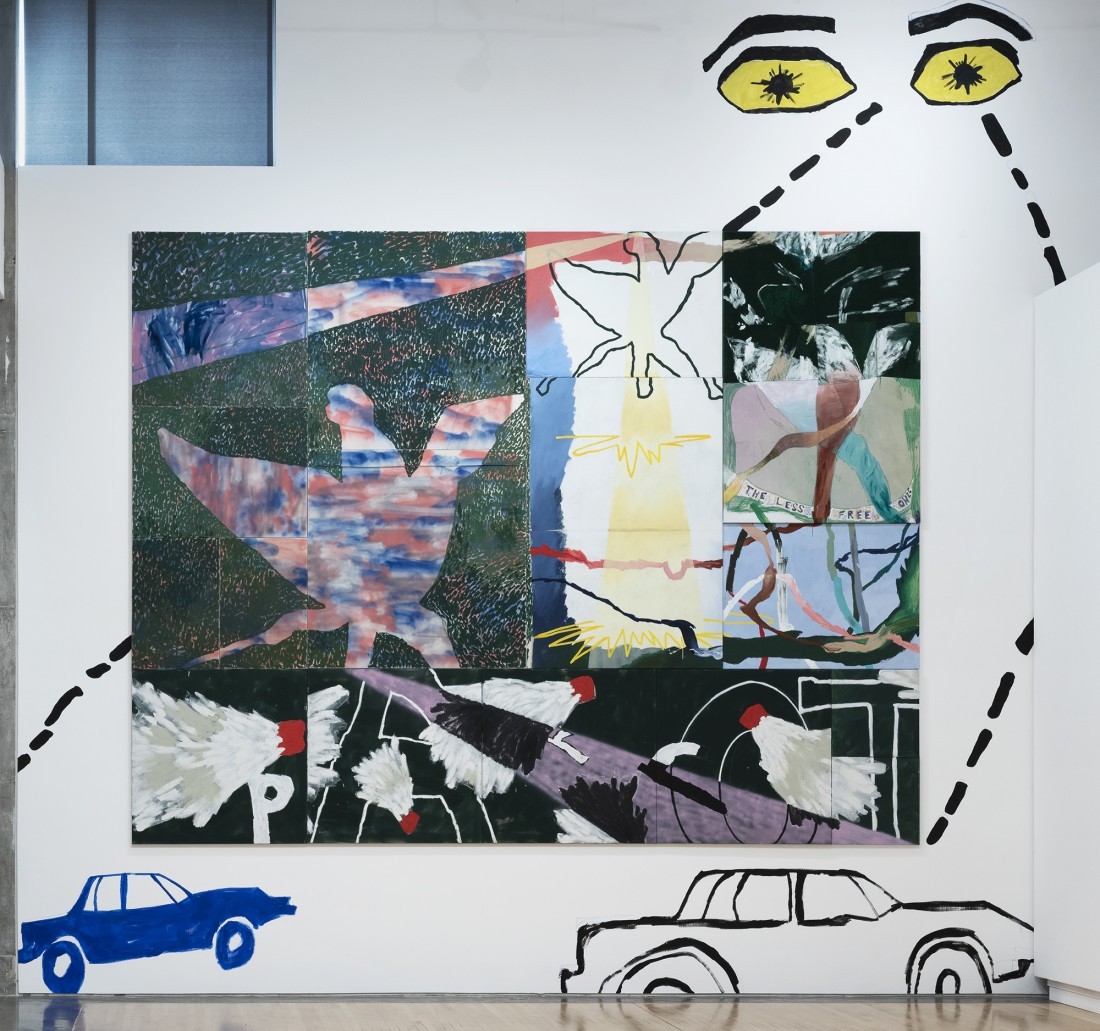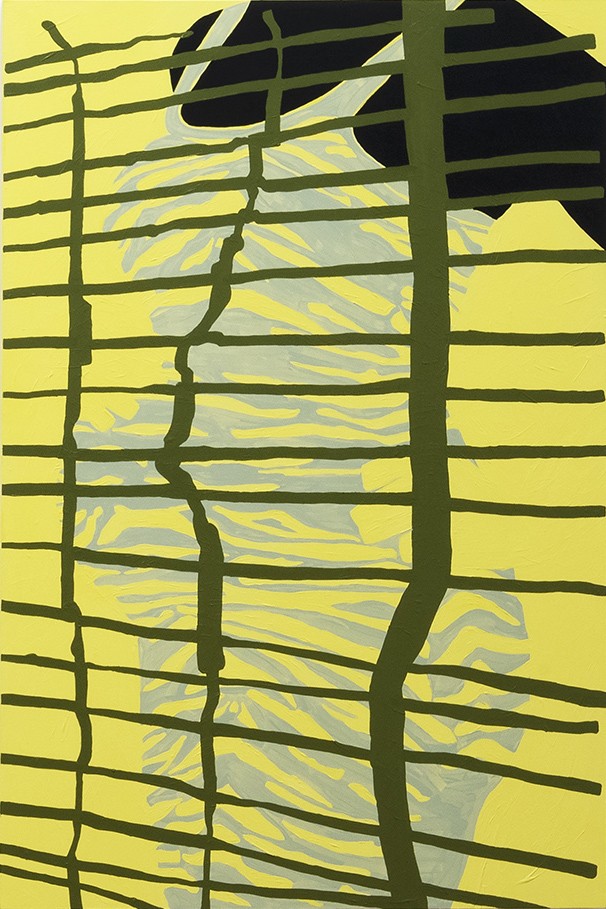“Holding a line in your hand”
What a summer it was in the central and southern interior of British Columbia. First came the heat dome, which saw temperatures soaring into the high 40s. Then the wildfires ravaged the countryside, even razing villages like Lytton, and Monte Lake. Gale-force winds were a near constant, no rain for months on end, smoke blotting out sun and sky, evacuation orders and citizen alerts, and let’s not forget the pandemic’s continued stranglehold on society. Amid all of the stress, strife and suffering there were admittedly a few bright spots and one of them surely had to be a painting exhibition titled “Holding a line in your hand” at the Kamloops Art Gallery. Curated by Charo Neville, the exhibition featured five artists, all women: Azadeh Elmizadeh, Colleen Heslin, Russna Kaur, Lyse Lemieux and Rajni Perera. What a treat it was to see a contemporary painting show again, especially one with such diversely inventive content and stylistic representation.
Rajni Perera is well known for her exotic science fiction aesthetic and often highly decorated, symbolically hybrid female figures who enact various scenarios orchestrated to the pictorial narratives. The first artwork visitors would encounter was a large in-situ wall painting. The colourfully designed figurative work, titled Protectors, 2021, which filled the entire wall, was painted with latex house paint, frequently thinned to optically exploit the white ground of the drywall surface. And, as is the case with good illustrative and chromatically coloured drawing, Perera left ample white space to both counter and graphically contextualize the dominant and fantastical figures. Interpretations of the composition posed a challenge to the audience’s deconstructive imaginations. However, I learned that Protectors was based on the persistence of wildfires in the area surrounding Kamloops and regions to the north, south, east and west. The three smallish grey figures with propellerlike head appendages were said to represent smoke, while the large ornamentally decorated figure on the right presumably represented fire, coloured as it was in a range of reds, yellows, oranges and violets, and equipped with a threatening set of talons and fighting spurs. To the left, a large figure in blues, female by certain appearances, presented an outstretched hand from which a calm swirling ring of smoke appears to waft away like a fleeting memory. Perera was also represented by a selection of small wood sculptures from 2017, three giclée prints from her “Dancer” series, 2021, and a beautiful little mixed-media on paper titled Not Waiting, 2018, which portrays a seated woman, nude except for decorated forelegs and a head garment that falls to the floor and under her behind.

Colleen Heslin, from left to right, Full of limited potential, 2021, Breaking waves, 2021, To grow and to shrink, 2021, and Fading pathways, 2021, dye on sewn canvas. Courtesy the artist and Monte Clarke, Vancouver. Photos: Garnet Dirksen.
In this exhibition Lyse Lemieux’s multi-faceted practice was represented by a generous quantity of medium- to small-sized canvases, supplemented by three fabric works, one of which, Tall Collars, 2016, had three vertical components. The fabric work perhaps seemed out of sync amid the lineup of paintings. However, it did introduce the audience to this possibly underexposed aspect of her production. Lemieux’s paintings are in acrylic and flashe on canvas; line is her trademark compositional anchor, and what an accomplished drawer she is. Her works are bold semi-abstractions, some quite colourful, but it could be argued that the strongest paintings are achromatic, such as Untitled Black 1 and Spider Dress, both 2021. It would be interesting to know if she does preparatory drawings for her canvases, as these might provide a deeper insight into her conceptual and improvisatory aesthetic.
Colleen Heslin’s medium is dye on sewn canvas, and, yes, each colour section in her fully abstract compositions is also a separate piece of canvas, meticulously stitched to adjacent canvas sections. She’s a bold colourist, often favouring two-colour compositions with quasi-geometric designs, but What is a Body?, 2021, was a departure and a standout for its multicoloured yet very subdued palette, which, in a curious way, reminded me of the late British abstract painter Ben Nicholson. Its more pronounced hues around the perimeter edges, framing a vast inner expanse of soft, warm greys, created a very contemplative, relaxed interior space.

Russna Kaur, Fixed, faith, freedom, 2021, acrylic, pastel and spray paint on canvas, cotton, velvet and silk. Courtesy the artist.
For the exhibition Russna Kaur produced an exterior banner titled Sideway sound; pieces exhibited inside the gallery featured, in part, direct wall painting. She works in a painting/assemblage manner, deploying mixed-media production materials on surfaces such as panel, velvet, silk, canvas and cotton, what Deleuze and Guattari have termed “constellations,” which they further describe as “imaginative contingent articulations among myriad heterogeneous elements.” In the main Kaur’s is abstract work with a heavy dose of symbolic motifs, emphasizing line, flat colour planes, fragmented compositional structure and intricate patterned areas, all conjoined on multiple material surfaces. It was evident that Kaur has a lively imagination and a tremendous capacity for improvisation, which, in addition to her unorthodox approach to colour compositions, communicates a truly uninhibited creative and conceptual approach. The artist cites her Punjabi ethnicity as a contributing factor in devising her decidedly unique palette. This was most evident in the work titled Fixed, faith, freedom, 2021. Its large multi-part square format work was installed proportionate to the wall dimensions, beyond which she worked directly on the wall with a sequence of broken line drawing, a crude rendering of two cars at the floor plane. High on the upper right corner are what appear to be two large yellow eyes partially encircled by black eyebrows and contour lines. This graphic wall treatment sat in a disjunctive relationship with the sensuous surfaces, nuanced colour modulations and symbolic abstraction of the dominant picture plane, yet somehow, remarkably, worked. Another mixed material and mixed technique work from 2021, titled Burnt away in layers of clouds they fall slowly … suspended in air, free as a gift, featured a large colour-field expanse of Matissian green over which lines of blue, off-white and brown carve wandering pathways to unknown destinations. The poetic title aside, the loosely gridded, rectangular picture plane occupying the lower section of the composition presented a broken poetic narrative with signifying graphic motifs and colours that suggested a landscape subject.

Rajni Perera, in background: Protectors, 2021, wall painting; in foreground: Positive Object Forms, 2017, wood, paint. Courtesy Patel Brown and private collection of Devan Patel.
Recent Guelph MFA grad and 2020 Joseph Plaskett Award-winner Azadeh Elmizadeh also evokes landscape and figuration in her atmospheric, diaphanously coloured near abstractions. At a glance the paintings do appear abstract, and to a large extent they are. However, on close inspection human figures can be identified, usually in pairs, as in Weaving Light and Sowing Seeds, both 2021. Circling Around, 2020, has a number of people dancing in a circle; here the figures are more discernable as their silhouettes are largely backgrounded by a blueish spatial envelope. I am reminded of Matisse’s two variations of The Dance, 1909, which is plausible. However, Elmizadeh draws much of her inspiration from Persian miniature painting and Sufi cosmology, referring to her Iranian heritage. There’s an ambiguous mysticism embedded in the expressive centre of Weaving Light that, in my opinion, starts at the outstretched hands of the kneeling young woman and the seated male adult, and continues, in the blue semicircle, to their mutual eye exchange. This painting, like her others, and the entire exhibition for that matter, was a chromatic tour de force, a much-welcomed bright spot in an otherwise grey summer. ❚

Azadeh Elmizadeh, Sowing Seeds, 2021, oil on linen. Courtesy the artist and Franz Kaka.

Lyse Lemieux, Une Affaire Entre Moi et Moi and Enceinte, 2020, acrylic and Flashe on canvas. Courtesy the artist and Wil Aballe Art Projects.
“Holding a line in your hand” was exhibited at the Kamloops Art Gallery from July 17, 2021, to September 18, 2021.
Gary Pearson is an artist and professor emeritus at UBC Okanagan, in Kelowna, BC.

